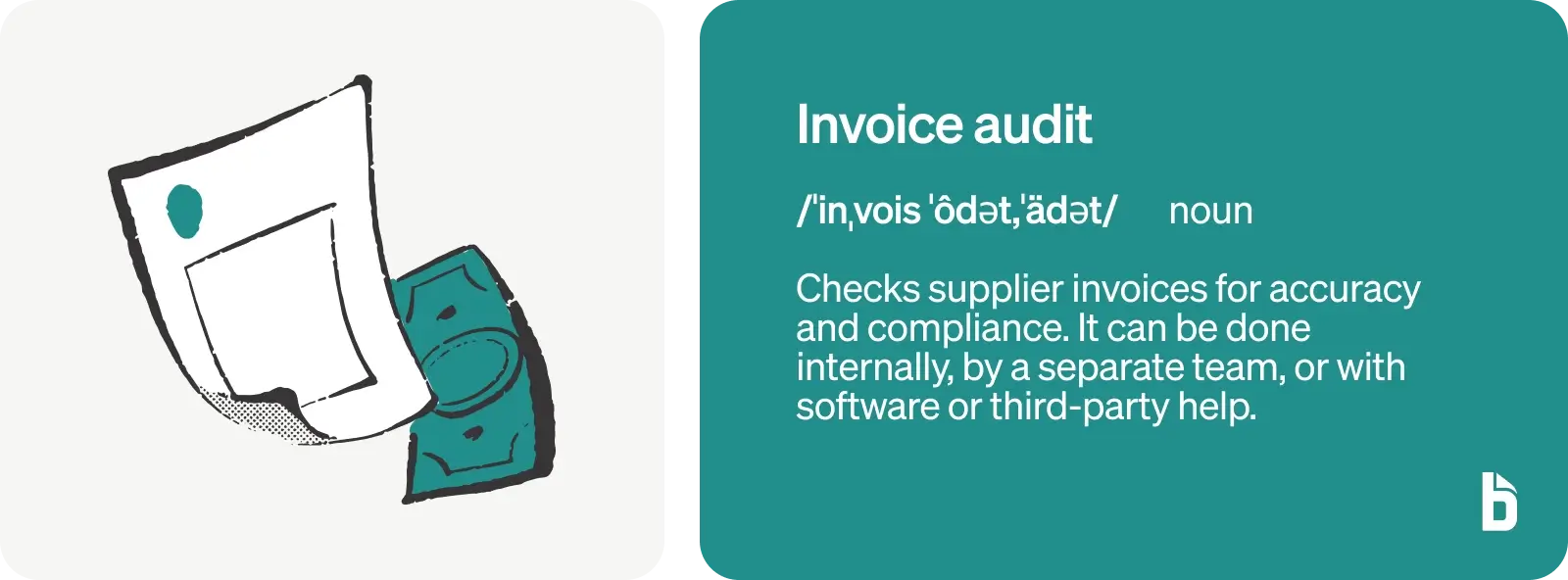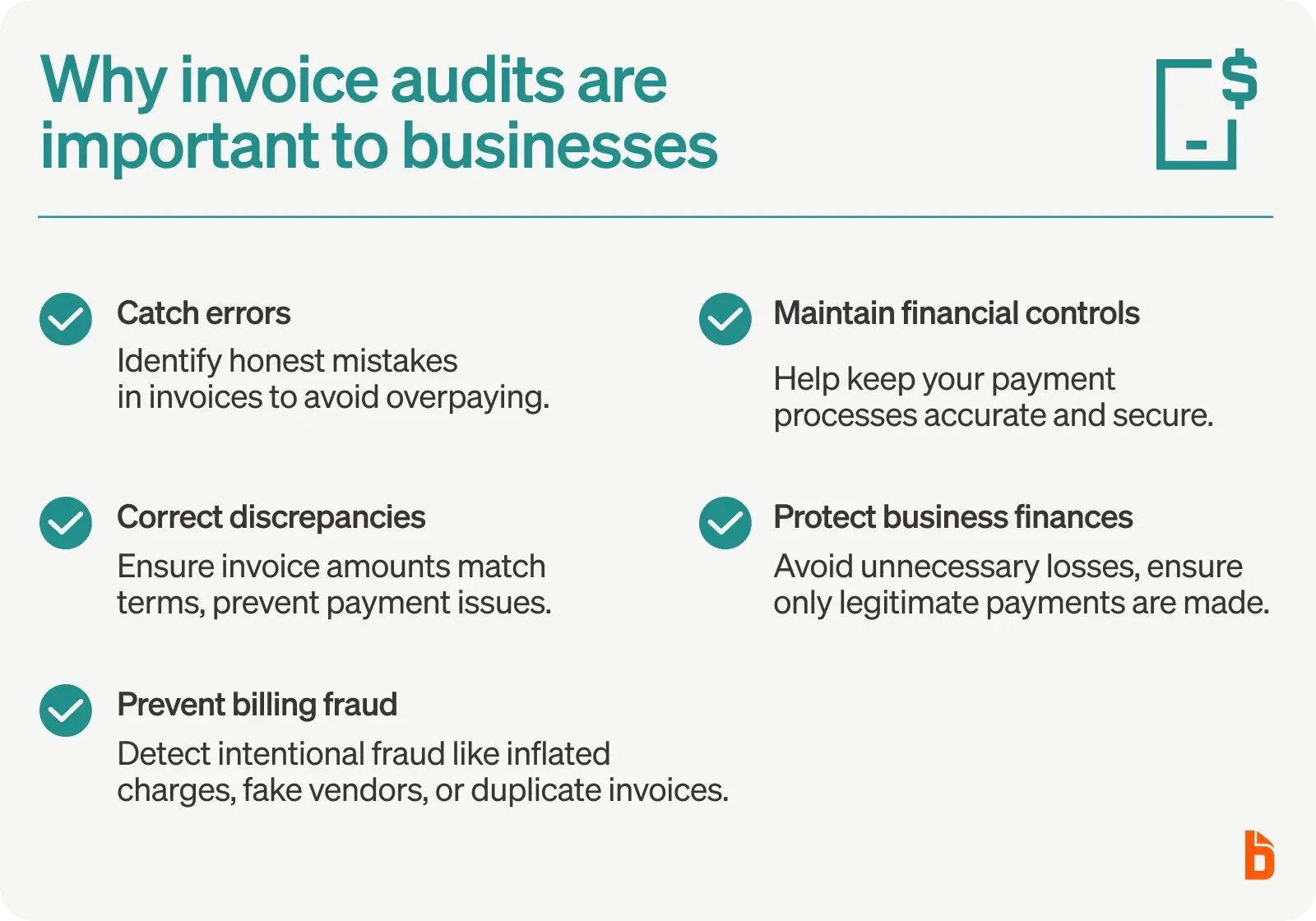In the accounts payable department, part of your responsibility is to pay vendors on time to keep bills from piling up and incurring late fees or penalties.
So, when you receive a new invoice from a supplier, you might want to give them the benefit of the doubt and approve payment without any extra thought.
But, even your most trusted and long-standing suppliers can make billing errors at times.
Supplier payments can make up a large portion of a business’s expenses each month.
Even slight discrepancies can have a major impact on your cash flows, nonetheless if you pay a duplicate invoice without noticing or make a payment to a fake vendor you’ve never worked with.
Luckily, invoice audits can help accounts payable departments address common concerns such as overpayment or billing fraud.
With the proper invoice audit process in place, your team can know what warning signs to look for in incoming invoices and how to handle incorrect information or discrepancies effectively.
Here’s how to kick off the process.

What is an invoice audit?
An invoice audit is the process businesses take to review supplier invoices for accuracy and compliance with set terms.
Invoice auditing is just one aspect of the larger accounts payable auditing process, which takes a broader look at the company to validate its accounts payable procedures, transactions, and general ledger.
Invoice audits can be handled internally. However, you may want to assign this process to a team separate from your AP department, like the compliance team, to prevent any conflicts of interest.
If you take this route, there are helpful automated AP software solutions that can help expedite the process (hint: BILL is one of them).
Or, if you'd prefer to have an external team complete this process, there are third-party providers that offer dedicated invoice auditing services.

Why are invoice audits important to businesses?
Businesses audit their invoices to catch errors, correct discrepancies, and prevent billing fraud attempts.
Essentially, this process helps ensure your business has the proper financial controls in place and is only making legitimate payments.
No team is perfect, and invoicing mistakes happen.
So, it's possible that some errors and discrepancies will stem from honest mistakes made by the supplier.
For instance, maybe their accounting team accidentally transposed two numbers so you ended up with an invoice totaling $2,100 instead of $1,200—which your team will want to catch to avoid overpaying by $900.
But, fraud can happen when a supplier intentionally sends you an incorrect invoice hoping you'll pay the amount before noticing the mistake.
Be aware that invoice fraud can appear in many different ways, including when:
- A supplier sends you an invoice with an inflated amount
- A fake vendor sends you an invoice for goods/services you never ordered
- You receive duplicate invoices to ones you've already paid
For this reason, you should have an established invoice audit process in place to catch both human error and intentional fraud before it’s too late.
Check out this article for tips to prevent vendor fraud.
What is the invoice auditing process?
The invoice auditing process can look different for each business depending on your unique needs and internal policies.
The audit can be as simple as a two-way or three-way matching process to ensure the invoice, corresponding purchase order, and receipt of goods are all consistent and line up with one another.
Or, it can be a more robust process involving invoice reconciliation against the general ledger.
In general, these are the basic steps to complete an audit and verify invoices for accuracy:
- Receive invoice
- Verify supplier details
- Compare the invoice amount against purchase orders or shipping receipts
- Confirm receipt of goods or services

Let’s take a deeper look at each of the steps in this process.
1. Receive invoice
The first step in the invoice audit process is triggered once you receive an incoming invoice from a vendor.
You will typically receive an invoice once services have been rendered or the goods have been delivered, which will be an important factor in a later step.
Your team should check the invoice number to see if it's a new and unique invoice, or if it's a duplicate of one that's already been sent. This will help you avoid making duplicate payments for one single order.
Record the invoice date and its due date to help prioritize payments, optimize cash flows, and prevent late fees or penalties.
You may decide to handle these one at a time as invoices come in.
Or, the accounts payable team may compile invoices for a certain period and process them in batches.
2. Verify supplier details
You should then verify the vendor's information to ensure they are legitimate.
You'll want to look out for fake suppliers trying to get you to pay for goods or services that were not rendered.
This step doesn't have to be too complicated.
But, the AP team should take the time to verify vendor information with previous invoices for consistency, like their:
- Business name
- Address
- Account number
- Phone number
- Logo
- Tax ID number
When receiving invoices from new vendors that your team doesn't recognize, you may need to confirm with the purchasing department that an order was actually made with the company before moving on to the next step.
If your team suspects they've received a fake invoice, it should be flagged for further investigation.
No payment should be made until the invoice and supplier has been verified for legitimacy.
3. Compare the invoice amount against purchase orders or shipping receipts
At this point, you'll dive deeper into the dollar amount on the invoice to ensure it matches what you have documented to avoid overpaying.
Put simply, you'll compare the amount on the invoice against the corresponding purchase order or receipt of goods.
If the two values match up, then you can proceed.
If there is an invoice discrepancy, you may need to investigate further and bring it to the vendor's attention.
Check to see that the sales tax was accurately calculated. Also, verify that the vendor has applied any necessary credits, rebates, or discounts and that they're accurately reflected in the invoice amount.
For example, some suppliers offer net terms with a discount if you pay the invoice within a certain time frame. It might appear like this on the invoice or purchase order:
This means they're offering you a 5% discount if you pay within 10 days of receiving the invoice.
Otherwise, full payment is due after 30 days.
If your business is paying the invoice within the given time frame, ensure you're paying the appropriate amount after applying the discount.
If you're being billed for physical goods, you will also want to verify the unit pricing shown on the invoice to ensure it matches what you were quoted or negotiated with the supplier.
This is a common area for discrepancies, so it's important to double-check this value during your audit.
4. Confirm receipt of goods and services
Once the invoice data has been verified by the AP team, you should confirm receipt of the goods and services before payment is approved.
The accounts payable team may do a physical scan or check of the delivered inventory to ensure it's in good condition and of the proper quantity shown on the invoice.
For services rendered, the AP department should verify that the contracted work is complete and satisfactory.
At any stage in the invoice audit process, if discrepancies, inconsistencies, or errors are identified, the invoice should be returned to the vendor for correction.
Any suspected fraud should be thoroughly investigated.
After the audit process is successfully completed and all invoice details have been verified for accuracy, the payment can be sent for approval.
Ready to automate your invoice audit process?
Invoice audits are highly important and help businesses avoid making fraudulent payments, overpaying invoices, or missing due dates.
However, manually performing invoice audits can be quite time-consuming for the accounts payable department.
Instead, you can automate many of the steps in an invoice audit by leveraging tools like those offered by BILL.
With BILL, you can:
- Import invoices with no manual entry
- Set up an invoice approval process
- Retrieve past invoices and other supporting documents
- Access real-time transaction reporting
- Automatically match invoices against POs and receipts of goods
If you want to establish your invoice audit process from scratch or enhance your existing audit workflow with the help of automation, get started with BILL.


